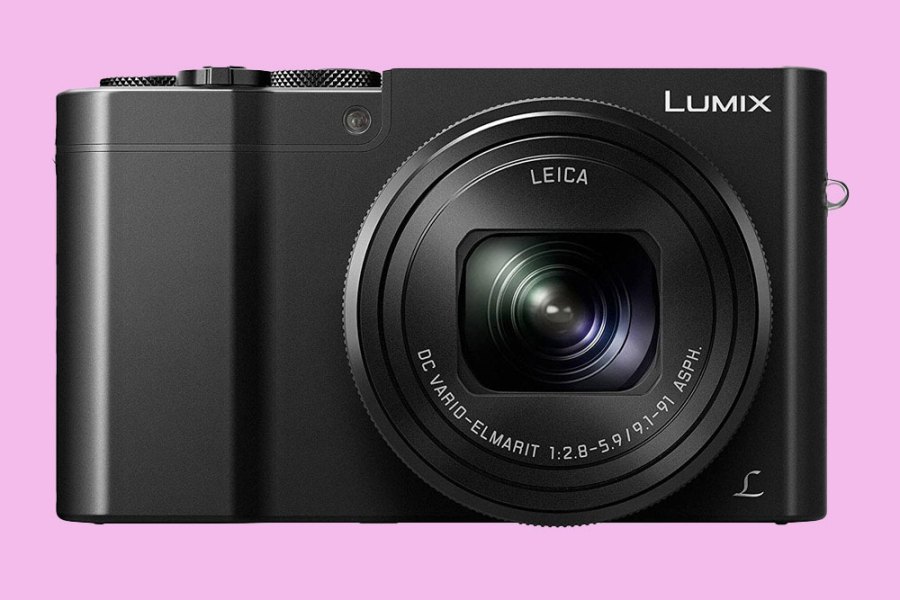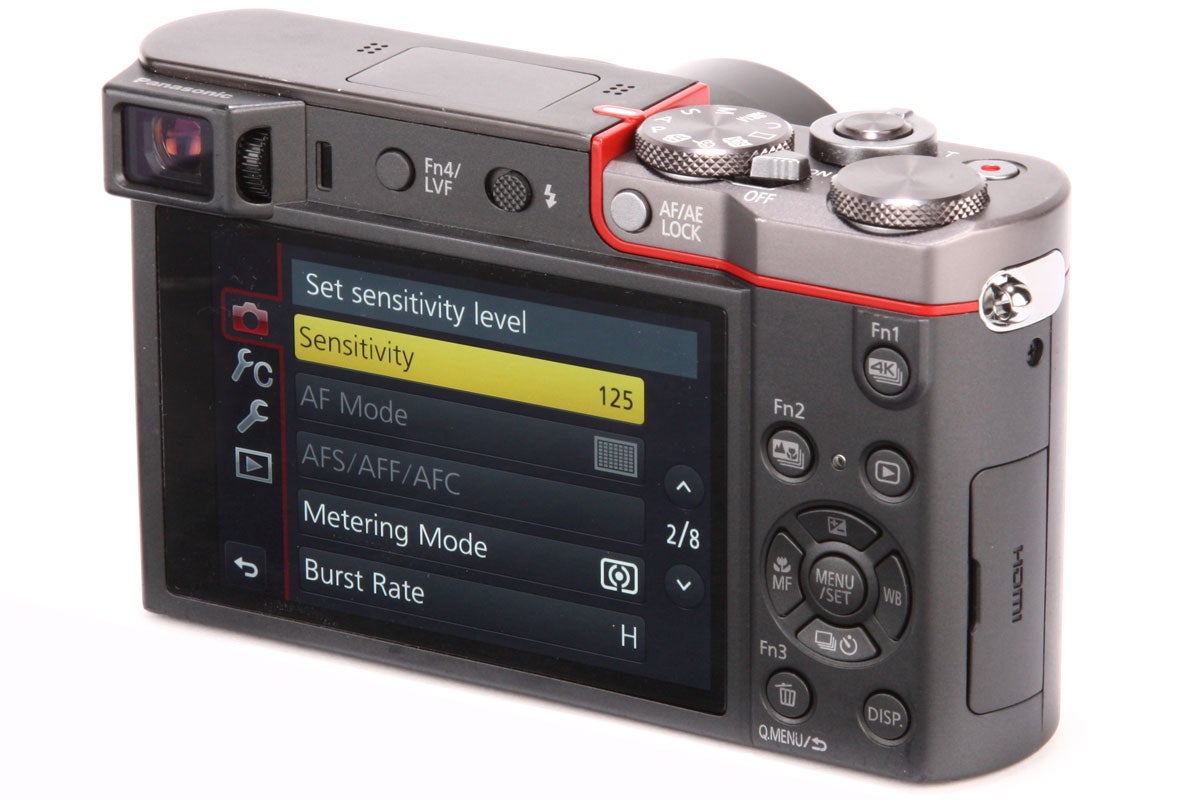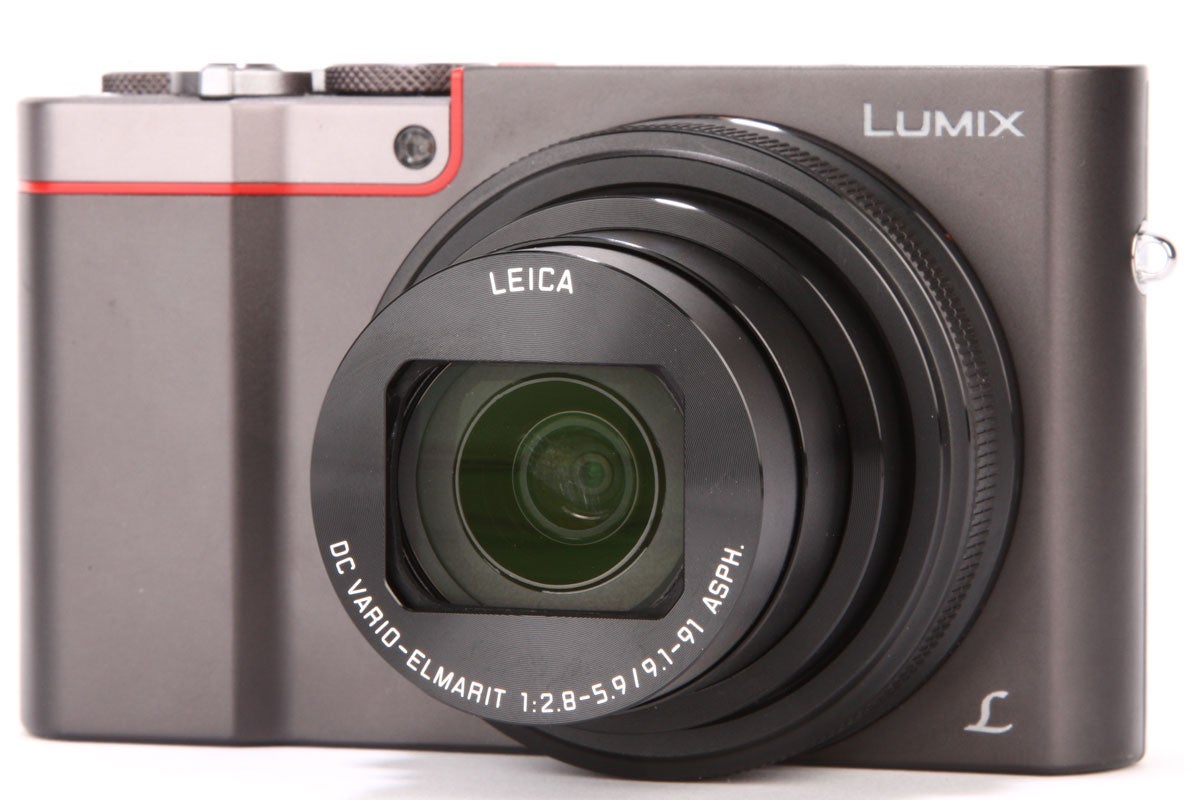Amateur Photographer verdict
If you’re looking for a small camera to take on holiday this summer instead of a DSLR, then without question, the Panasonic Lumix TZ100 should be right at the top of your shortlist.- Pocketable form factor
- Useful zoom range
- Small EVF
- Fixed rear screen
Perhaps because it was never a traditional film camera company, Panasonic has always tried to find ways of offering something beyond the ordinary with its Lumix cameras. It invented the ‘travel zoom’ class by combining a long zoom range with a compact, portable body, with the original TZ1 in 2006. It embraced video technology, offering high-resolution 4K recording in most of its cameras, along with associated 4K Photo modes that use the same technology to shoot high-speed stills. And Panasonic combined these in the TZ100 model.
Panasonic Lumix TZ100 – at a glance:
- 1in, 20.1MP sensor
- 25-250mm equivalent f/2.8-5.9 Leica DC lens
- ISO 125-12,800 standard, 80-25,600 extended
- 1.160-million-dot electronic viewfinder
- 1.04-million-dot 3in touchscreen
- 4K 30p/25p video recording and 4K Photo
- Price £529
The Panasonic Lumix TZ100 is also known as the ZS100 in some markets.
The first in the TZ series, the TZ80, was essentially an iteration of the TZ70, with a small 1/2.3in sensor and 30x optical zoom. However, the subject of this article, the TZ100, is a very different beast indeed. Instead, it employs a much larger 20-million-pixel 1in sensor and delivers much-improved image quality.
The main trade-off is a less extensive zoom, although its 10x 25-250mm equivalent range should still be more than sufficient for most purposes. This all fits in a body that’s just slightly thicker than the TZ80, and that fits easily in a coat pocket or small bag.

In essence, the Panasonic Lumix DMC-TZ100 shook up the travel zoom class much the same way Sony’s RX100 upstaged all previous enthusiast compacts back in 2012. For the first time, it gave the kind of image quality that won’t disappoint critical enthusiasts, in a way its smaller-sensor cousins could never quite manage. It also offers a decent level of manual exposure control, along with a built-in electronic viewfinder. The TZ100 proved itself to be the pocket travel camera that serious photographers have been waiting for.
Read on to find out what makes the Panasonic Lumix TZ100, almost a decade after its original release, a still sought-after pocket rocket, that’s a joy to use.
Panasonic Lumix TZ100 – Zoom range
The TZ100’s 10x lens covers a very useful 25mm equivalent wideangle to 250mm equivalent telephoto, illustrated below:

Panasonic Lumix TZ100 – Features
It’s safe to say that the TZ100 offers one of the richest feature sets of any pocket camera to date. First of all there’s that hugely flexible lens range, which covers a very respectable 25mm equivalent wideangle to a decently long 250mm equivalent telephoto. This immediately places the TZ100 in a class of its own among 1in sensor compacts for compositional flexibility; its closest competitor, the Canon G5 X, tops-out at 100mm. To get any more range, you’ll need a considerably larger bridge-type model.
The price you pay is a pretty modest f/2.8-5.9 maximum aperture (via f/4.1 at 50mm, and f/5.2 at 100mm), which makes the TZ100 less suited to low-light shooting or experimenting with shallow depth-of-field effects compared to shorter zoom cameras such as the Sony Cyber-shot RX100 IV or the Canon PowerShot G5 X. The minimum aperture is f/8, which makes sense on a 1in sensor to avoid excessive diffraction blurring, but means that overall there’s only limited adjustment available, especially at the long end of the zoom.
Headline specs include a native sensitivity range of ISO 125-12,800, which is extendable to ISO 80-25,600. Continuous shooting is available at 10fps with focus and exposure fixed at the start of the burst, or 5fps with focus adjustment between frames. Hybrid 5-axis optical/electronic image stabilisation helps avoid image blur from camera shake.
As I mentioned at the start, Panasonic has included 4K video recording, at frame rates up to 30fps. This technology enables 4K Photo mode, which in effect allows users to shoot high speed bursts of images and easily extract single frames as 8MP stills. It’s well implemented and genuinely useful when shooting moving subjects.
The firm’s recent 4K Post Focus mode is also included. This takes a series of images at different focus distances and stores them together as a movie format file, which in playback mode effectively allows you to refocus the image by tapping on the screen. Panasonic considers this sufficiently clever to merit its own button on the camera’s back, but I’m really not convinced it’s much more than a gimmick. There just aren’t that many situations where it’s useful.
Naturally, Wi-fi is built in, allowing you to control the camera remotely using your smartphone or tablet, and copy images to the device for sharing with friends and family. Oddly for a travel camera, however, the TZ100 doesn’t have built-in GPS. Instead, the idea is that you use your smartphone to record a GPS log via the Panasonic Image App, then geo-tag your images by syncing the data with the camera over Wi-fi. In practice, this actually works just fine as long as you remember to enable it on your phone, but it’s an additional step and less convenient than having the process built-in.
Panasonic Lumix TZ100 – Build and handling
With a metal body shell, the TZ100 feels sturdy and well made, as befits a £560 camera. The top-plate dials click with a pleasing precision and the lens control ring rotates with silky smoothness. Combined with the modern-looking design and smooth surface finish it really feels like a premium product.
The camera comes in two colour schemes, either conventional all black or the distinctively styled ‘red’ version we used for this review. This has a mostly gunmetal body with a contrasting titanium finish to the right top-plate, separated by a sliver of red. I wasn’t convinced by this at first sight, but quickly grew to like it. If anything, I’d love to see Panasonic offering more colours for that extra element of personalisation.
When you come to start shooting with it, though, the TZ100 quickly shows some limitations. The handgrip is very small, and there’s only a small, ill-defined space to put your thumb. Many camera manufacturers have taken to designing sculpted, ergonomic thumb grips as they can work wonders on small cameras, and it’s a shame Panasonic hasn’t followed suit here.
Combined with the slippery smooth metal finish, it means that the camera doesn’t feel very secure when held one handed. I’d recommend using a wrist strap at the very least, and ideally a better one than Panasonic supplies in the box.
For a camera that’s aimed at enthusiast photographers, the control layout leaves a little to be desired. The front control dial feels rather under-used: when it’s not being used for manual focus it simply replicates the function of the top dial in changing shutter speed or aperture. However, it can’t be used to change other settings, such as ISO, when they’re activated by pressing a button; instead you have to use the d-pad or top dial, which ends up needing a lot of thumb movement.
Oddly, that top dial works in the opposite direction to normal when changing exposure settings: to select a smaller aperture or faster shutter speed, you have to rotate it clockwise by moving your thumb leftwards.
Pressing the ‘up’ arrow on the d-pad accesses exposure compensation. This is fairly standard for a compact camera, but still annoying for anyone who’s become used to a dedicated dial.
Strangely, ISO isn’t assigned a button by default, but I set it onto the 4K Post-Focus button (Fn2). The focus area can be set using the touchscreen, but I found I frequently set it accidentally with either my thumb brushing the top right corner of the screen or (being a left-eyed shooter) my nose. If you can’t get on with using the touchscreen, then you can assign one of the physical Fn buttons to access focus area selection instead.
Most secondary settings can be accessed either from the d-pad or the onscreen Q Menu. With Panasonic’s well-considered touch interface, this allows you to access and change a lot of options very quickly.
The touchscreen is also handy for browsing images during payback. However, if you don’t want to use it, you can turn it off completely and just use the buttons and dials instead, although this may slow some things right down.
All in all, I found the TZ100 perfectly useable, although not as nice to shoot with as the best enthusiast compacts around, particularly when using the viewfinder. However, you won’t find a travel-zoom type camera that handles much better.
Viewfinder and screen
The TZ100 / ZS100 offers two viewing choices while shooting, either the built-in 1.14-million-dot electronic viewfinder or the 3in 1.04-million-dot LCD.
At just 0.42x magnification, the EVF is really very small and it’s rather high in contrast, too, giving a distinctly different rendition of the scene compared to the LCD. Even so, it’s very useful when shooting in bright light, and a lot better than not having an EVF at all. But I’d have much preferred to see a larger viewfinder, even at the expense of camera size.
The rear screen is very good, giving a more accurate preview of the final image than the EVF, but its fixed design now feels like an anachronism. Clearly Panasonic is aiming to keep the camera’s size to a minimum, but I missed the additional compositional flexibility offered by a tilting or articulated screen.
Panasonic Lumix TZ100 – Autofocus
Panasonic has spent a long time perfecting its AF systems and the TZ100 benefits from the firm’s unique Depth from Defocus technology. This uses knowledge of the lens’s optical characteristics when the image is out of focus to determine the correct focus distance.
The system works remarkably well, focusing quickly and accurately in almost any situation. The focus point can be placed anywhere in the frame using the touchscreen, and face detection and subject tracking modes can be enabled.
Often cameras with relatively slow zoom lenses struggle with focusing in low light, but the TZ100 performs remarkably well. It’s only really when trying to shoot in extremely dark conditions that it shows any sign of failing. So if you want to take a lot of pictures in very dimly lit bars, it may not be the best choice; otherwise it should be just fine.
Switch to manual-focus mode and the dial around the lens becomes a manual-focus ring. Panasonic has included a peaking display and magnified view, which can be combined together. I found this made it easy to achieve manual focus when desired, except in very low-light situations where the display becomes too noisy.
Panasonic Lumix TZ100 – Metering, white balance and colour
Left to its own devices, the TZ100’s metering handles most scenes relatively well. It doesn’t quite have the uncanny consistency of the best of its peers, though, and I found myself using exposure compensation fairly frequently to either tame clipped highlights in bright light, or brighten up dark exposures in dull conditions. Of course, the great advantage of electronic viewing is that you can see all of this before you take the shot, and there’s the option of a live histogram to help you judge correct exposure.
Panasonic’s standard JPEG colour rendition is accurate and perfectly pleasant, although not as punchy or crowd-pleasing as some other brands. In terms of white balance, under most conditions the TZ100 gives neutral results, and while under artificial light it errs to the side of warmth, it’s not unpleasant. Crucially, the odd colour casts that previously could beset Panasonic cameras seem to have been eliminated. On occasions when the camera does get things wrong, you can use the well-implemented in-camera raw development to choose a more appropriate white balance.
Low ISO images are packed full of fine detail, but even at ISO 400 noise starts to have a visible impact in detail if you look closely at your images. Even so, I was quite happy shooting up to ISO 1600, which gives results plenty good enough for online sharing and small prints.
Higher settings result in noisy images with little shadow detail, but can still be usable on occasion, especially when converted to black & white. Meanwhile, the lens delivers plenty of detail at wideangle and holds up well through to about 100mm equivalent, but gets noticeably softer beyond. The optical image stabilisation works well, but only within reason: if you try to shoot one-handed at full telephoto, for example, you’ll likely get shaky results.
Panasonic Lumix TZ100 – Pocket camera lenses: range vs speed
The other small pocket cameras currently on the market all use shorter zooms, with rather faster maximum apertures. In many ways this is the main factor to consider when choosing between the TZ100 and cameras like the Sony RX100 IV series or Canon G5 X.
Which is the better choice depends hugely on how you shoot. I tend to use telephotos quite a lot, so the TZ100 suits me well. I also found that the lens’s slow aperture wasn’t quite the handicap I expected in low light, given the sensor’s decent performance at high ISOs and the effective image stabilisation.

The example at the top shows a bar interior shot at ISO 6400, while that above is a night-time shot taken at ISO 12800 towards the long end of the zoom. Image quality of the former is marginal, and a camera with a faster lens would have been preferable here. However, for the second, I’d have needed to crop heavily to get the same composition, revealing more noise and negating any advantage of the faster lens.
Panasonic Lumix TZ100 – Image quality
Over the past few years the 1in 20.1MP BSI-CMOS sensor that’s used in the TZ100 has become very familiar, and the image quality Panasonic is extracting from it is absolutely as we’ve come to know and love.
At base ISO there’s stacks of detail and not very much noise, but raising the sensitivity setting sees detail loss from noise and noise reduction becoming detectable as low as ISO 400. But while it’s best to stick to low ISOs as far as possible, you’ll still get entirely tolerable results up to ISO 1600. It’s important to get exposures as close as possible to correct, though, because there’s not as much leeway for adjusting exposure after the event in post-processing as you’ll get from raw files from larger-sensor cameras.
Panasonic Lumix TZ100 – Resolution
With its 20.1MP sensor, the TZ100 can record a whole lot of detail, and this shows in our resolution tests. As usual, it performs best in raw, and here we see it achieving at least 3400 l/ph at low ISOs with the lens set to 35mm (equivalent), which is about as much as we could possibly hope for.
Noise starts to have a clear impact on detail at ISO 800 and by ISO 3200 resolution has dropped to around 2600 l/ph. At the top standard setting of ISO 12800 and the extended ISO 25600 setting, resolution falls even further due to the impact of noise.
Below are 100% crops taken from our resolution chart, using raw files converted in Adobe Camera Raw. Multiply the number below the line by 200 to get the resolution on lines per picture height.
Dynamic Range

The main take-home message from our Applied Imaging dynamic range tests is that, while the TZ100 scores very well at low ISO, the numbers fall off very rapidly as the sensitivity is raised.
A measured dynamic range of 12.4 EV at ISO 100 indicates that it’s possible to pull a fair bit more detail out of dark shadows when processing raw. But by ISO 800 this ability has more or less completely gone, and at ISO 3200 and above, low readings indicate that there’s very little shadow detail at all. Sub-6 EV readings at the top ISO settings emphasise their poor quality.
ISO sensitivity and noise
At low ISO settings, TZ100 files show lots of detail with just the barest hint of noise. At ISO 800, luminance noise is beginning to mask fine detail if you look at your images closely, but this unlikely to show up in prints of 12x8in or smaller.
By ISO 3200, however, there’s a much greater impact on fine detail, but Panasonic’s JPEG processing maintains colour well. ISO 6400 is about as high as you’d ever want to go, with little in the way of shadow detail remaining, and the higher settings are very noisy indeed.
Below are 100% crops taken from JPEG files, shot at 44mm equivalent and f/5.6:
Switch to raw files processed in Adobe Camera Raw and we see a typically different rendition, with less smearing of detail and more luminance noise. But the overall message is much the same: image quality is excellent at low ISOs and perfectly acceptable at ISO1600, but tails off at higher settings.
Panasonic Lumix TZ100 / ZS100 – Verdict
Let’s get one thing straight from the start – the Panasonic Lumix DMC-TZ100 is the best pocket travel camera money can buy right now.
Its 1in sensor and 25-250mm-equivalent lens give a great combination of image quality and zoom range in a body that’s still small enough to slip into a jacket pocket. I took it on a week-long trip to New York expecting to use it occasionally as a backup to my ‘proper’ camera, but ended up carrying it all the time instead, and found it delivered fine results under almost any conditions – indoors or outdoors, sunny or cloudy, day or night.
This is its purpose in life, and it fulfils it better than any of its peers. Yes, I’d have got technically better image quality from a DSLR or CSC, but I was pleased with what I got from the TZ100, and it was so much easier to carry around.
Indeed, in practical use, the TZ100 is a quite likeable little camera, although the EVF is painfully small and the lack of a tilting screen is disappointing.
The controls aren’t as well thought out as the best enthusiast compacts I’ve used either, so not all functions are very easy to access quickly.
In terms of handling, it feels rather like a point-and-shoot that’s developed pretensions to greater things, but that’s not surprising given its lineage.
Overall, the TZ100 reminds me very much of the original Sony RX100: it’s operationally flawed and sometimes frustrating to use, but capable of results so far ahead of its smaller-sensor rivals that it practically renders them obsolete. Literally nothing else on the market can offer a similar combination of zoom range, portability and image quality.
If you’re looking for a small camera to take on holiday this summer instead of a DSLR, then without question, the TZ100 should be right at the top of your shortlist.

Panasonic Lumix DMC-TZ100 review: First look
This is an archived version of our original hands-on first look article about the TZ100, with additional images
At a glance:
- 1in, 20.1-million-pixel sensor
- 25-250mm equivalent f/2.8-5.9 Leica DC lens
- ISO 125-12,800 stnadard, 80-25,600 extended
- 1.160-million-dot electronic viewfinder
- 1.04-million-dot 3” touchscreen
- 4K 30p/25p video recording and 4K Photo
- Available in March for £529
Ten years ago, Panasonic launched a whole new class of camera, with its DMC-TZ1 ‘travel zoom’ that managed to combine a long zoom lens with a relatively pocketable form factor. It’s dominated the market for such cameras ever since, progressively extending the zoom range and adding features. Its most recent models, the TZ60 and TZ70, added such desirable extras as electronic viewfinders and raw format recording, and were some of the best-selling cameras of 2014 and 2015.
The problem with this camera type has generally been that fitting a long zoom into a small body requires use of a tiny 1/2.3″ sensor, compromising image quality. In turn this means that the cameras have generally been pitched at casual photographers rather than enthusiasts. With its latest model Panasonic has addressed this head-on, by using the much larger 1in sensor seen in many recent compacts. This means that, at a stroke, the TZ100 becomes the best travel zoom model we’ve yet seen.
Features
At the core of the TZ100 is the familiar 20.1MP 1in sensor that’s found its way into a lot of cameras over the past couple of years. However, while these have had either a short zoom in a small body, or a long zoom in a large SLR-like body, Panasonic has managed to fit a 10x 25-250mm equivalent zoom lens in a camera that’s barely larger than its existing small-sensor models, at 110.5 x 64.5 x 44.3mm and 312g (in effect, the protruding section of the lens barrel is about 1cm deeper). With a very decent wideangle to telephoto range, the lens should cover the majority of photographic opportunities. Panasonic’s Depth From Defocus technology promises fast autofocus, while hybrid optical / electronic 5-axis image stabilisation is on hand to keep images sharp.
The maximum aperture ranges from f/2.8 at wideangle to f/5.9 at telephoto, via f/4 at 70mm and f/5.6 at 180mm equivalent. This means that the FZ100 won’t be such as good choice for low-light shooting as cameras like the Canon PowerShot G5 X with its 24-100mm equivalent f/1.8-2.8 lens, or the rather larger Sony Cyber-shot RX10 II with its 24-200mm equivalent f/2.8 optic. It’s the main price you pay for fitting an extensive zoom range into a relatively small camera.
Like other recent TZ models, the TZ100 has an electronic viewfinder tucked away at the top-left of its body. With 1.16-million-dot resolution, it’s acceptably sharp, but it’s not very large, giving something of a ‘postage stamp at the end of a tunnel’ experience. It’s about the only disappointing aspect of the camera, and I would have been happier to see a larger viewfinder on board, even at the expense of increased size and price.
On the back is a 3” LCD, and in a very welcome move, Panasonic has added touch sensitivity. This enables AF area selection by touch, even with the camera held to your eye, and several 4K-related tricks along with Panasonic’s usual excellent touch interface. Unfortunately the screen isn’t articulated, which is bad news for selfie-lovers. However Wi-Fi is built-in for remote control of the camera and image sharing. Other features include a small pop-up flash, and in-camera raw development.
Build and Handling
With a price tag of £539, the TZ100 is clearly aimed more towards serious photographers than its small-sensor siblings, and its build quality and handling reflect this. It feels more solidly-made, with a sturdy metal shell, and the external controls are more extensive. The smoothly-rotating control dial around the lens is joined by a top-plate dial for adjusting exposure settings that clicks positively as it turns, and the d-pad on the rear gives direct access to key settings. There are also four programmable function buttons. So while the TZ100 should still be a very capable point-and-shoot, it won’t leave enthusiast photographers feeling short-changed in terms of controls.
4K video features
Panasonic considers 4K video recording to be one its core technologies, and has included it on the TZ100. Movies can be recorded at 3840 x 2160 px resolution and 30 or 25 fps, or at Full HD (1920 x 1080 px) if you prefer. Sound is recorded using built-in stereo mics. One neat new feature is ‘4K Live cropping’, which allows footage to be recorded as a Full HD-size crop from the 4K stream, which can be zoomed or panned around the image area using the touchscreen, without having to move the camera.
Panasonic has also thrown in its latest 4K Photo mode. This allows easy extraction of 8MP still images from bursts recorded at 30fps and saved as MP4 files, and even gets its own button on the back of the camera. In a slightly more gimmicky fashion, there’s also Panasonic’s latest 4K Post Focus mode, which records a series of frames at different focus distances as a movie file and then allows refocusing after the event.
First Impressions
While travel zoom cameras are incredibly popular among casual photographers, they have for a long time been the poor relations of enthusiast-oriented compacts with larger sensors, due to sub-par image quality. As the first camera in its class to feature a 1in sensor the TZ100 promises to change all that, and with its solid build and decent external controls, it has the potential to be a great option for photographers when they’re travelling light once it goes on sale in March. It certainly redefines its class, and we’re really looking forward to getting our hands on one for a full review.
You’ll find even more bargains in our buying guides, or in our second-hand section.
Related reading:
- 12 best second-hand classic compact cameras
- Panasonic TZ90 vs Panasonic TZ100
- Best compact cameras – get better quality than your phone
- Travel photography tips for packing light




















































